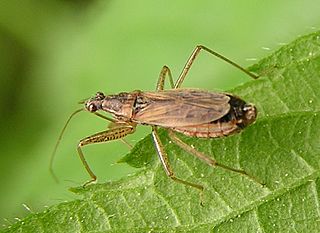
Pyrrhocoridae is a family of insects with more than 300 species world-wide. Many are red coloured and are known as red bugs and some species are called cotton stainers because their feeding activities leave an indelible yellow-brownish stain on cotton crops. A common species in parts of Europe is the firebug, and its genus name Pyrrhocoris and the family name are derived from the Greek roots for fire "pyrrho-" and bug "coris". Members of this family are often confused with, but can be quickly separated from, Lygaeidae by the lack of ocelli on the top of the head.

The insect family Nabidae contains the damsel bugs. There are over 500 species in 20 genera. They are soft-bodied, elongate, winged terrestrial predators. Many damsel bugs catch and hold prey with their forelegs, similar to mantids. They are considered helpful species in agriculture because of their predation on many types of crop pests.
The Metapterini are a tribe of thread-legged bugs, assassin bugs of subfamily Emesinae.

Centrocoris spiniger is a species of family Coreidae, subfamily Coreinae.
Fulvius is a genus of plant bugs in the subfamily Cylapinae.
Perittopus asiaticus is a species of riffle bug from Malaysia, China, and Thailand.
Tachygerrini is a tribe of water striders containing 21 species in 2 genera. In addition to the two extant genera, Eurygerris and Tachygerris, Andersen included the extinct genus Eurygerris within the Tachygerrini.

The Blissidae are a family in the Hemiptera, comprising nearly 50 genera and 400 species. The group has often been treated as a subfamily of the Lygaeidae but was resurrected as a full family by Thomas Henry (1997).

Arocatus is a genus of bugs in the family Lygaeidae.

Arocatus melanocephalus, the elm seed bug, is a true bug in the family Lygaeidae. The species was initially described by Johan Christian Fabricius in 1798, and Maximilian Spinola designated it to be the type species of the genus Arocatus in 1837. This bug is native to Europe but has been introduced to North America.

Xylocoris is a genus of bugs in the monotypic tribe Xylocorini of the family Anthocoridae. There are approximately 50 described species in Xylocoris worldwide. Nearly 30 species occur in the Palaearctic Region, 10 are known from the Nearctic Region, and 6 from the Oriental Region. They occur in various habitats, often found under plant litter and under tree bark where they feed on small arthropods. Certain species inhabit stored food facilities.

Microvelia buenoi is a species of smaller water strider in the family Veliidae. It is found in Europe & Northern Asia and North America.

Lasiochilinae is a subfamily of bugs, in the family Anthocoridae; some authorities place this at family level: "Lasiochilidae". It is most diverse in tropical areas, especially in the New World.

Physopelta is a genus of bordered plant bugs in the family Largidae. There are about 30 described species in Physopelta, found in Asia and Oceania.
Pachytomella is a genus of mostly European capsid bugs in the tribe Halticini, erected by Odo Reuter in 1891. The species Pachytomella parallela is recorded from northern Europe including the British Isles.
Sagriva is a genus of dinidoridae bugs. It occurs in South and Southeast Asia. Originally described in 1850 from the species Sagriva vittata, no other species were known for over a century, making the genus monotypic for that time. A second species, S. banna, was described in 2017.
Nemorius is a genus of horse flies in the family Tabanidae.

Nematopus indus is a species of insect from the genus Nematopus.
Cavelerius saccharivorus, also known as the oriental chinch bug, is a small Asian true bug in the order Hemiptera and family Blissidae. It feeds by sucking the sap out of the stems of grasses and grass-like plants, including rice plants and sugarcane. Cavelerius saccharivorus is notorious for the damage it wrought to sugarcane plantations in Japan, China, and Taiwan in the early 20th century, from which it derives its Latin name saccharivorus, meaning "sugar-eater". Even today, the insect is still listed as one of the 100 most economically-devastating invasive species to Japan by the Ecological Society of Japan.
Anhanga is a genus of Brazilian shield bugs, erected by William Lucas Distant in 1887.










